TL;DR
- Setting up Facebook campaigns isn’t as complex as it looks, just follow the process step by step.
- Start by creating a goal and setting up objectives in Facebook to help acheive it.
- Input your audience targeting and how much you want to spend.
- Build your ad creatives and you’re good to go!
Find out how you can create a Facebook ad campaign – but also how to ensure that it’s successful. We’ll start with the basics and then dig into how to avoid the common mistakes that often plague newcomers and waste money.
A quick side note – page optimisation
If you’re ready, let’s find out how to find, target and convert the potential customers hiding among Facebook’s 2.38 billion monthly active users.
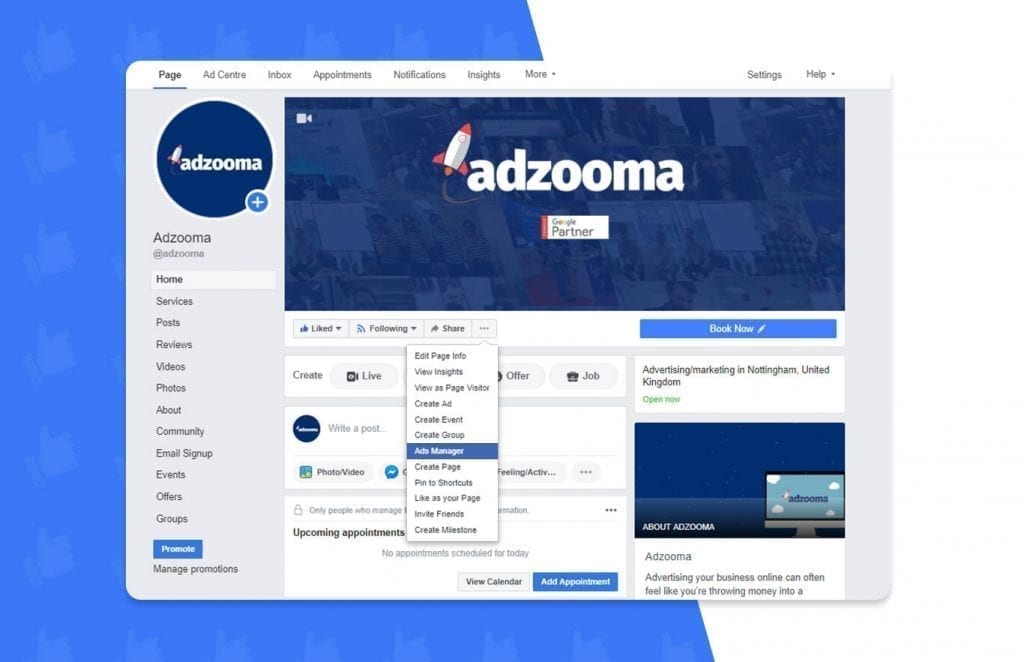
You won’t see the crucial “your ads” section on Facebook without first having a Facebook Ads account. You should also create a business or public page first before getting started. This is because it’s extremely likely that your Facebook Ads will perform worse without one. There’s a great guide to creating a Facebook page on Buffer.
This isn’t the place for discussing how to optimise your Facebook page. Get your campaign set up by following this guide and then go elsewhere to make sure everything is optimised before you hit the go button.
That said, you must optimise your landing page. This is whatever location someone who clicks your ads will turn up at.
Facebook is pretty user-friendly: it’ll give you page tips, and you need to follow them because parts of the Facebook Ads’ algorithm incorporate how optimised your pages are. There are tools like Canva and guides on how to optimise landing pages and the best image tools available to help you get this done for images.
But we’re here to talk about the campaigns. Let’s go!
What the Facebook Ads manager does
The Facebook Ads manager is billed as the all-in-one tool for creating and managing ads. It’s designed to be powerful and feature-rich but also approachable for newcomers. Here’s just some of the stuff you can do with it:
- Set up your Facebook Ad campaigns
- Create your ad sets and ads
- Manage Facebook Ad bids
- Pinpoint target audiences
- Optimise your ad campaigns
- Analyse the performance of your campaigns
- Split test your Facebook campaigns
How to use the Ads Manager
There are three main ways to log onto Ads Manager:
- Login from the Business manager webpage.
- Click on the drop-down arrow in the upper-right corner of your Facebook page and select “Business Manager”.
- Use the Ads Manager mobile app (on Android and iOS) and to access and manage your ad campaigns wherever you are.
There are four tabs to concern yourself with. They are:
- Account Overview
- Campaigns
- Ad Sets
- Ads

Think of this setup as a forest and its trees. The overview is the forest. The Campaigns are the trees. The Ad Sets are the branches. The Ads are the leaves.
The campaigns are what give your account structure. The Ad Sets are what allow you to precisely target your audience. The ads are responsible for bringing in your growth.
This will do for now, but if you want to know more right now about structure head over to Facebook’s advertising campaign structure guide or look at specific differences between campaigns, Ad Sets and Ads.
Let’s look at an overview of the Ads Manager.
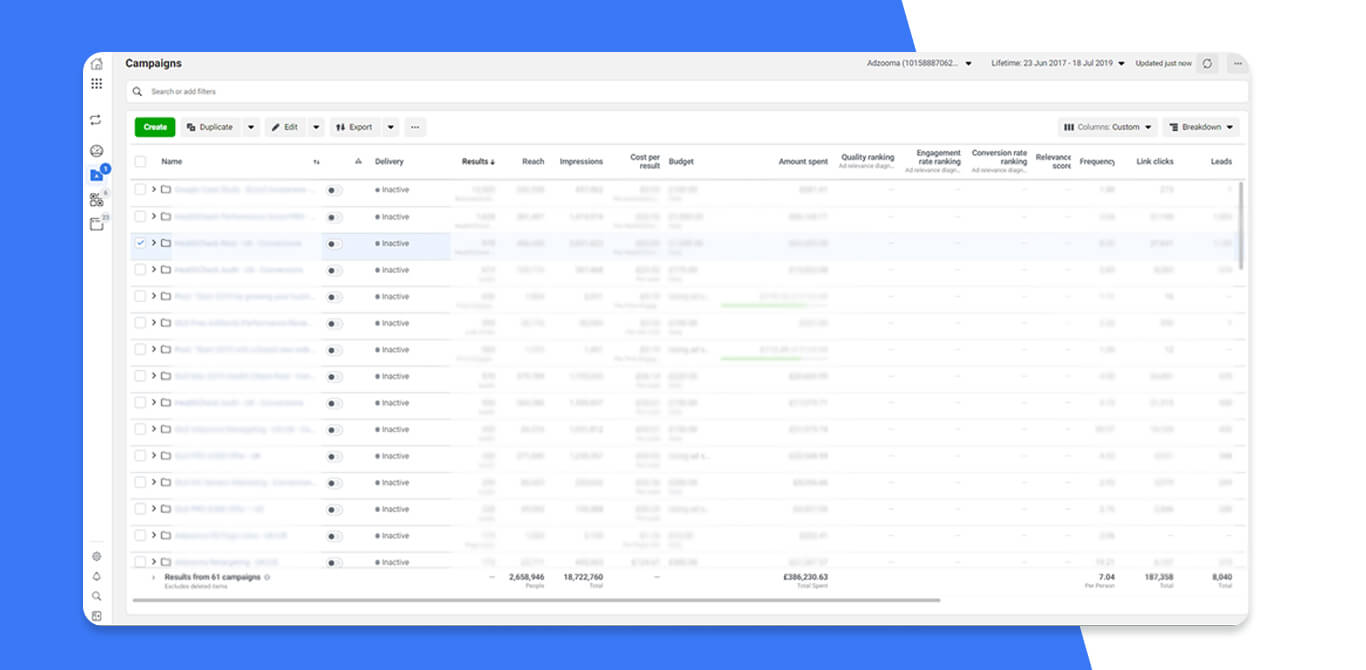
Admittedly, there’s a lot to take in here. Take some time to click around and get familiar with where everything is. When you’re ready, find the Ads Manager navigation menu in the top left and then select “All Tools” towards the bottom of the window. Here’s where you find a raft of settings but, importantly for us, the ad creation tools.
How to create an effective Facebook ad campaign
Again, Facebook Ad Campaigns are the trees of the Facebook Ads forest. To create one, navigate to the “campaigns” tab. From there, click on the green create button.
Step 1: Campaign objectives
No sensible person ever sets out to spend money without any idea of what they want to get in return (better known as “Return on Investment” or ROI). Facebook Ads is no different, and it’s important to choose a campaign objective that aligns with your goal.
“What’s your marketing objective?”
There are three categories:
- Awareness (including brand awareness and reach) – You want people to know the name of the new brand of trainers you’re launching
- Consideration – You want people to be interested in buying your brand of trainers.
- Conversion – You want people to click the ad and buy your brand of trainers right now.
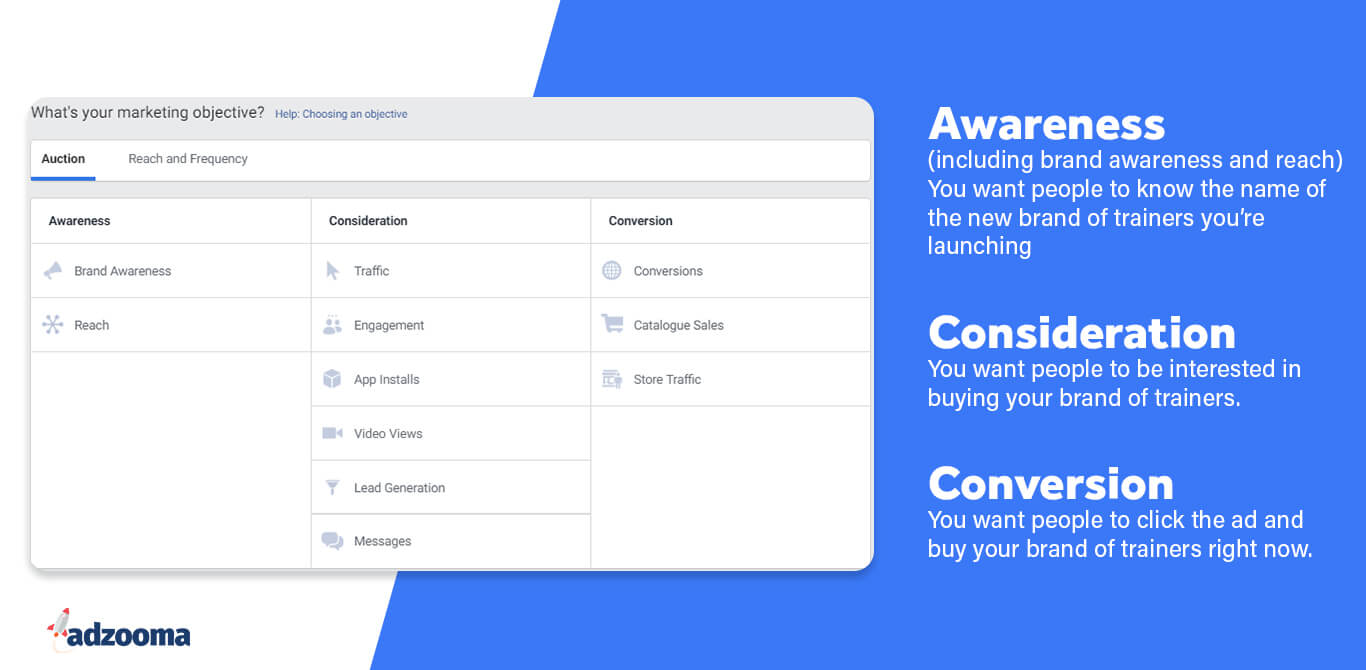
It’s best to think about this in terms of what you want someone to do. For example, if you’re looking to capture email addresses, you’re looking for lead generation under conversion. You want someone to click the ad, drop on your lander and then convert by typing their email address.
If you’re just starting out, it’s a good idea to focus on lead generation under conversion. You’re looking to get people to give you their details.
A few exceptions might be if you want to:
- Generate traffic to your web site. That’s coming under consideration > traffic.
- Get the most page likes or event responses. That comes under consideration > engagement.
- Get the most app installs. That’s under consideration too.
- Get the most video views. That’s under consideration as well.
Quickly: video ads are generally the cheapest option for advertisers right now. This is because Facebook is looking to disrupt the dominance of YouTube when it comes to video advertising.
Done right, you can do some pretty great things with video ads. But you should be extremely careful of people who say that Facebook video ads are the only thing that makes sense right now in online advertising because they’re so cheap.
That’s rubbish.
But if you’re just getting started, please consider the following. Be very careful using awareness. Brand awareness and reach might put your advert in front of people who don’t really care about what you’re selling, which means you don’t want to use this until you’re very big and have money to burn on brand awareness and reach (which are notoriously difficult to measure and test).
And, you should definitely be testing everything you’re doing to make sure it’s delivering on your objectives.
Step 2: Name Your Campaign
Keeping your campaigns organised is essential. It may seem like a silly step initially, but as you scale up you need to be able to easily identify each of your campaigns at a glance. It also helps to simplify the reporting process later.
Here’s a good naming convention: De Brugg Hotel – Over 50s affluent women – Video – De Brugg 20% Off Spa Breaks.
In turn, it covers:
- The client name or website (De Brugg Hotel)
- The target audience/location (over 50s affluent women)
- The creative type: video, carousel, collection, etc. (video)
- The specific Facebook page your ad is linking to. (De Brugg 20% off deal)
Step 3: Set Up Optimisation Or Split Tests
You should always be testing your adverts and optimising. Run experiments, collect data and see what performs – never assume anything.
For a newcomer, this comes really early in the process. Skip it for now – but definitely come back later when you have everything else set up.
Remember the rhyme: if you’re not testing, you’re just jesting. Horrific isn’t it? Almost as horrific as running ads without testing to see if they could be doing better.
Step 4: Set Up Audience Targeting
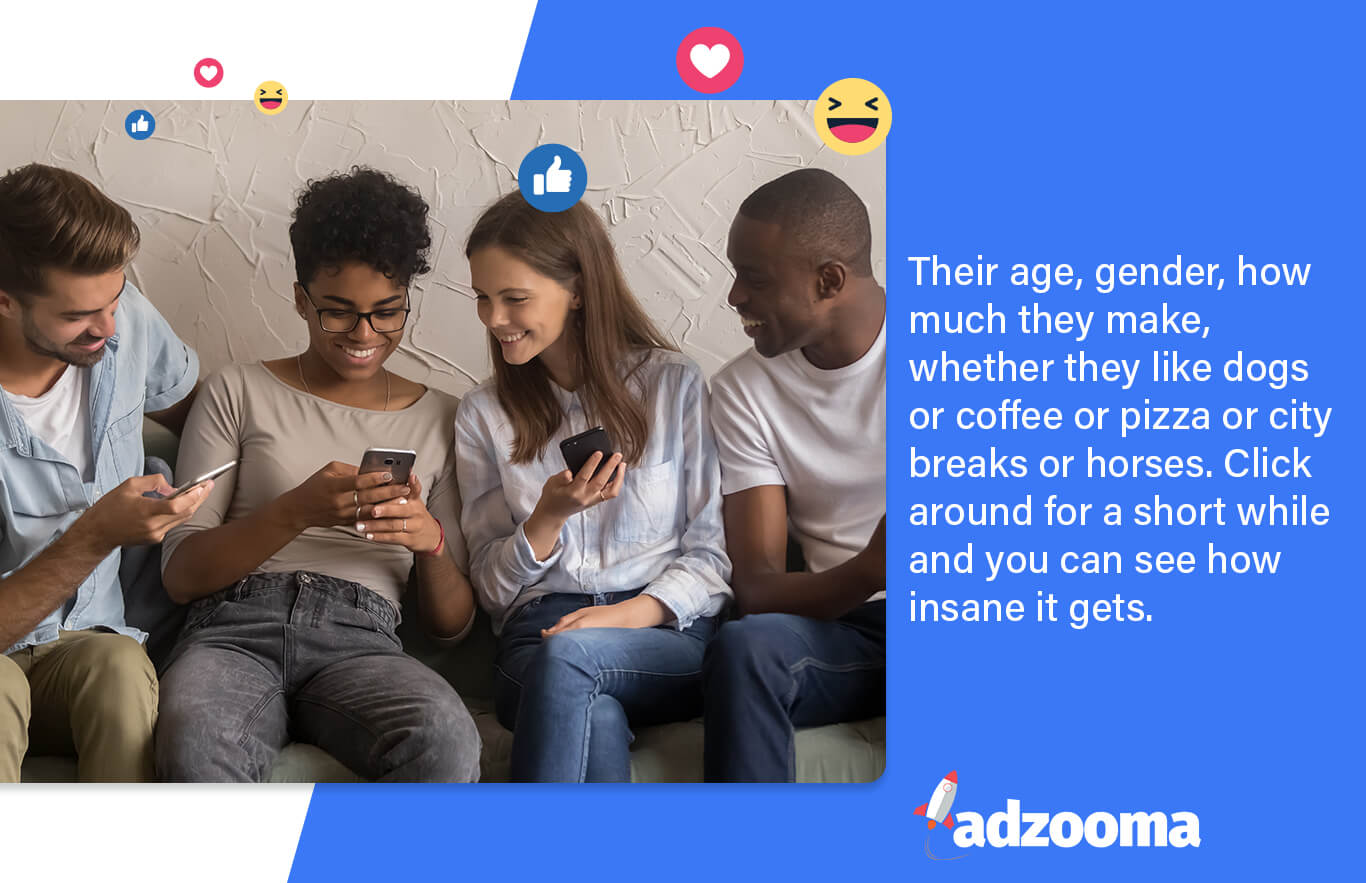
Literally, the number one benefit of online advertising is your ability to pinpoint your audience. What’s the point of showing half a million people your TV ad if the vast majority don’t care?
Online advertising allows you to target people who are likely to be interested in your ad.
Facebook gets terrifyingly specific about this. Want to know why Facebook’s 2018 revenue was upwards of $55 billion? It’s because people volunteer a gigantic amount of information about themselves for free.
And that’s a big win for advertisers.
Their age, gender, how much they make, whether they like dogs or coffee or pizza or city breaks or horses. Click around for a short while and you can see how insane it gets.
Closely monitor the “too specific / too broad” gauge. Aim for the middle ground and you will struggle to go wrong.
Either:
- Create a new Facebook target audience
- Reuse one you have previously saved
And remember to give every audience you create a sensible name so you can save yourself some work later.
Step 5: Set Up Your Ad Placement
If you don’t mess with the settings, Facebook will serve your ad to Facebook, Instagram and its Audience Network. It will try and optimise your placements for the best results.
If you have some data, you can tweak this. But if you’re just getting started, it’s strongly advised that you leave Facebook to its own devices.
When data starts coming in about how the placements have done, you can start tweaking.
Step 6: Set Up Your Campaign Budget and Bidding
Let’s quickly recap: campaign, Ad set, Ad = tree, branches, leaves.
A campaign (tree) can contain several Ad sets and has a unique campaign objective.
For example, let’s say you had two goals: sell more trainers on your website and increase the number of likes on your PlutoShoes Facebook page. These would best be organised in two different campaigns.
A Facebook Ad set (branch) can include multiple ads and can have unique audience targeting, budget, schedule, bidding and placement. They’re the best way for you to split test ads. Create an ad set and then test variations of your ad within that ad set.
The Facebook Ad (leaf) is the smallest component and probably the piece you’re creating right now.
Knowing this makes setting up the campaign budget easier. There are two key options:
- Daily budget – Facebook will spend this amount every day delivering ads in your campaign. It’s a little weird because Facebook optimises for best results. That means, technically speaking, Facebook could spend up to 25% more than your budget on certain days when it identifies opportunities. But, don’t worry, this will average out month-on-month. It might just be that people buy more guitars or ladders or candles in your area on Tuesdays.
- Lifetime budget – Facebook will divide a total budget across specified campaign dates. If I set January 1st – March 31st, it will spread my spend out across these dates.
For people just starting out, it makes the most sense to set a daily budget with unlimited duration so that you can tweak them as and when you like.
Ad delivery optimisation comes right after setting up the budget. So, make sure they align with your goals.
In our example above, we were focused on lead generation under conversion. So here we would choose “conversions” optimisation goal as we want people to come to our landing page and leave their details.
It’s too much for us to cover here, but here’s a full guide on Facebook Ads bidding and scheduling. Keeping it blunt: we recommend going for lowest cost bidding models for your first campaigns.
Read: How Much Does Facebook Marketing Cost?
Step 7: Set Up Your Facebook Ads
This is what people will actually see. Trying to cover all the various ingredients that make a good Facebook Ad here won’t work, but there are other places that cover this information.
Quick rundown? Make it look good, use free (or paid) software to help ensure all of your ad sizes are correct and run lots of variations of your ad to get plenty of split test data.
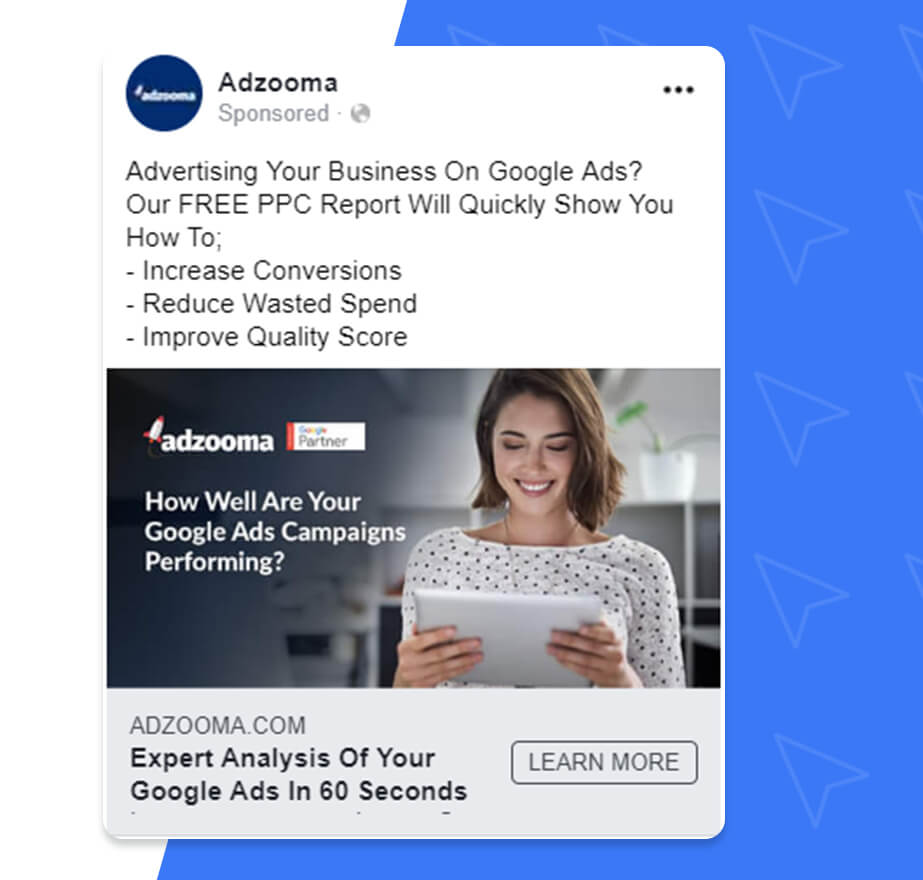
Step 8: Publish
You’re finally ready to hit the green button. Double and triple check everything and hit go. Try not to sit there at the computer hitting refresh to see if you’ve got any data yet.
What to do next
Running Facebook campaigns is hard work and it’s ongoing. At least every week, you should be checking your results. Which ads are performing and which are lagging behind? Are there some new creatives you can test? Can you tweak your audiences to make them broader or more specific?
Never adopt a “set it and forget it” attitude when it comes to your Facebook Ads. There are always little tweaks you can be making and tips you can be following.
This is why platforms like Adzooma exist – to make optimisation easier for you.
Adzooma analyses your account data 24 hours a day and pinpoints where you can optimise your campaigns. Many of these improvements can be applied with a single click.
Not only that, you can automate repetitive online ad tasks and also manage your Google Ads in the same beautifully designed place.



